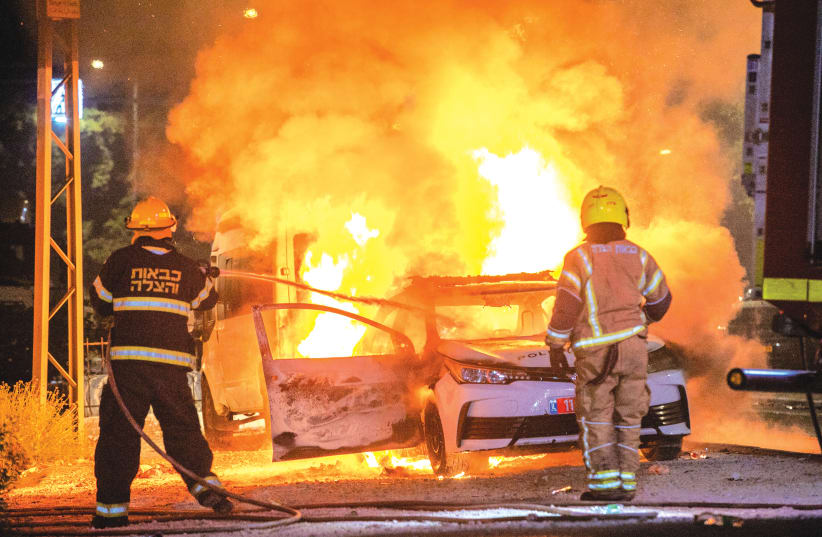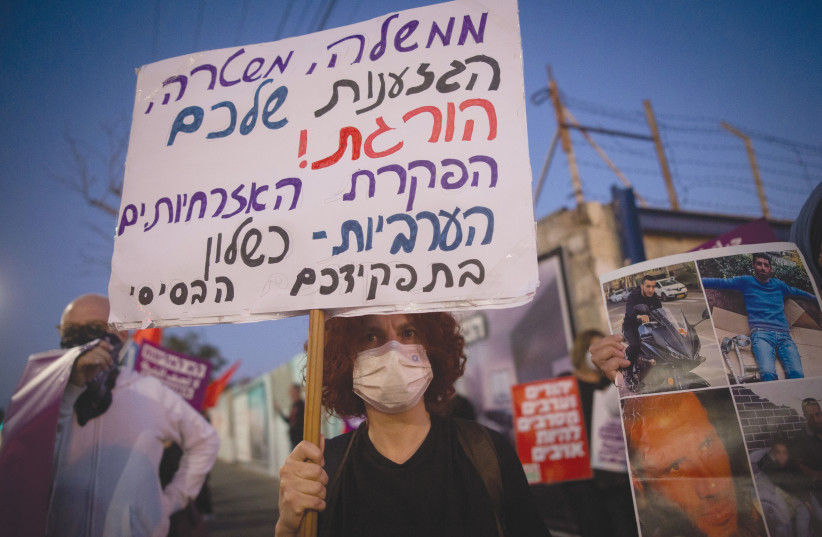One of the major turning points in the formation of the recent government in Israel was the willingness of the Ra’am Party to participate in the coalition.
This helped enable a coalition of mostly Jewish parties to unseat former prime minister Benjamin Netanyahu after he had clung to power for 10 years. But the participation of Ra’am is also interesting because it doesn’t represent the participation of the historical Arab Left in Israel, but actually the religious Right.
This is not entirely a historical first. Arab parties have played a role in Israeli coalition politics, not only in the 1950s when some worked with the ruling Labor Party, but also in the 1990s when they remained outside the coalition but supported Yitzhak Rabin’s government. Ra’am made a major choice to be in the coalition and participate openly in meetings.
The odd thing here is that the more likely candidate for participation in a coalition to unseat Netanyahu should have been Ayman Odeh, whose roots are in the Hadash Party, which includes Jews and Arabs and has roots in Communist voters in Israel.
Yet Odeh refrained from participation, in part because he runs the Joint List, which includes Arab politicians who have hostile views about any role in an Israeli government.
In short, the radical Left which supposedly embraces coexistence opposed the coalition, while more religious right-wing Arab voters appeared to support it.
At the same time that this historic compromise was made by Jewish and Arab parties to work together in a coalition, there is also evidence that Arabs in Israel are making major strides economically.
This may represent a shift from economic success on the local level – where businesses thrived in villages but where tax avoidance, gray markets and a shadow economy also thrived – to integration.
Israel often ignored the Arab sector in the past, not developing public transport, highways or rail lines that served Arab areas. Because most communities in Israel are divided, that left a quarter of the country almost off the grid. In the Negev it left more than 100,000 people of Bedouin origin truly outside the grid, lacking basic things like electricity, health clinics, parks and schools. In other areas, it meant roads didn’t have signs, and massive numbers of housing starts were undocumented or illegal. Planning was almost nonexistent.
Despite that persistent issue, today there is more recognition that integration is possible. Dror Bin, the chief executive officer of the Israel Innovation Authority, spoke to CTech by Calcalist recently. “This issue is also very much related to the integration of underrepresented populations – ultra-Orthodox, Arabs and women. If we want to increase the human capital, we must reach populations that are not represented in hi-tech: most immediately, the women who are already at the center of the country and available, and also reaching out to the ultra-Orthodox and the Arabs.
“A dedicated plan has been drawn up for Arab society with a budget of NIS 250 million ($78m.) for the next five years,” he said. “There will be a program that will combine employment and entrepreneurship in Arab society. This is the first time that the State of Israel has invested such an amount in the integration of the Arab population.
“We do not want there to be two countries here, one thriving hi-tech state while the other is left behind.”
THE REASON that Israel’s leaders are doing more outreach to the Arab minority may be multilayered.
+972 Magazine quoted Rasool Saada, an attorney who directs the Safe Communities Initiative at the Israeli social change network Maoz. The article notes that the Jewish state “found that Arab society was more ready and willing to cooperate, Saada explains. Accordingly, the government began turning its attention to meeting more of Arab society’s needs – primarily to serve its own economic interests.”
The article says that Saada sees success in this political interest and “a push that we all feel on the ground. Each side knows that this is likely a onetime and brief situation, in which the stars have aligned for the good of both sides in Israeli society.”
There are corollaries to this change as well. Arab society is changing. More Arabs are getting degrees in higher education. A recent study based on interviews with Arab women “shows that a combination of higher education and joining the workforce have challenged the traditional marriage dynamic.”
There are also many new initiatives by hi-tech firms to engage with Arab communities. One program saw more Druze women join a fintech firm.
There is still a lot of work to be done. One study showed that while there are 4,000 Arab engineers working in Israeli hi-tech, they make up only 1.5% of the tech workforce.
MoveUp, a collaboration between the UK Israel Tech Hub at the British Embassy and Presentense, in partnership with CITI Foundation and Takwin VC, has been aiding Arab society to integrate into the hi-tech workplace, according to an article at Jewish News.
WHILE THERE is integration politically and economically, there is also a push for the security forces to stop widespread gun violence that harms the Arab community.
For many decades the state ignored violence in Arab towns and villages because it believed it wasn’t worth tackling as long as it did not become “nationalist” or include terrorist attacks. That meant that gun violence, drugs, gangs and domestic assaults were largely ignored.
This went hand in hand with a suspicion by locals against working with the Israel Police. In some places the state was seen as almost an enemy.
Israel, cognizant of the need not to provoke and antagonize and thus push Arabs into a more nationalist camp, sought to simply do nothing.
This was part of the Netanyahu status quo that preferred pushing various issues off rather than confronting entrenched interests among Arabs, ultra-Orthodox and other groups. He pushed off the Prawer plan, for instance, to organize Bedouin communities in the Negev.
Now the new government wants to deal with these issues via economic support and also using the security services, such as the Shin Bet (Israel Security Agency) to go after illegal weapons.
The weapons became a clear threat during the May clashes in Gaza, when there was widespread violence in some mixed towns, where Jews and Arabs lynched one another. Lod fell into anarchy, and locals say the Israel Police and Israeli politicians appeared to abandon the city for days. The result was that armed men from Jewish communities in the West Bank went to Lod to help protect Jewish communities, while armed Arabs were also seen on the streets.
It took days for the police, with Border Police and other units, to restore order. That situation made Israel look, temporarily, like it had the sectarian militia chaos that has harmed Iraq and Lebanon.
The government now wants to collect the illegal guns. It is difficult for citizens to obtain legal firearms, but evidence shows that there are thousands, if not tens of thousands of weapons held illegally throughout some Arab communities in Israel. The firepower at the disposal of gangs, Israeli mafias and others is huge.
Some videos in the Negev have shown men at weddings using what appear to be guns stolen from IDF bases. For years IDF soldiers have complained they were unable to stop the thefts. That means that while a weapon stolen in the West Bank would be tracked down, some felt nothing was being done inside the Green Line. Now that may be changing. But the question is whether the attempt to seize illegal weapons will be met with violence.
In Kafr Kassem a worrying incident involved violence against police. “I have expressed my unequivocal condemnation to Police Commissioner Kobi Shabtai, wished a speedy recovery to the police officers, and emphasized the obligation to uphold the rule of law and cooperation with police,” Ra’am’s Abbas said, following a phone call to the police chief.
Israel Hayom says that Arabs are demanding “governance” in their communities. However, it is not clear how increased policing or the use of the security forces will be greeted. It may be that in some communities things will go differently. Justice Minister Gideon Sa’ar has said the violence in Arab communities is a greater threat than Hezbollah.
But if Israel treats these communities like havens for terrorists, it could create a cycle of resistance. That is what Israel has always feared since the 1950s. No one wants to enable Hamas or extremists to gain a foothold. This means that illegal construction, illegal weapons and even the infiltration of extremist preachers into mosques – sometimes informed by networks linked to Hebron and even as far afield as Turkey – have been ignored.
At the same time, it is worth recalling that some communities like Kfar Kassem have bad memories of Israeli security forces’ violence in the past. In 1956, Israeli forces gunned down 48 civilians in the town, killing 23 minors and children under 18. Other more recent incidents, in 2000 and other years, have led to the killing of Arab civilians by security forces.
BEYOND THE security issue and the desire to get Arabs integrated into the workforce, there is also a major difference between vaccination rates of Arabs and Jews in Israel. This also affects the Orthodox community, where suspicion of vaccination means they are less likely to be vaccinated. Reports show that in August only half of the Arab community was vaccinated compared to two-thirds of all Israelis.
What this means is that suspicion of the authorities has led to less vaccinations, and therefore Arabs make up a disproportionate number of those harmed by serious Covid cases. A September report said 40% of new Covid cases were among the Arab community.
This points to a crossroads in Israel. A major drive is taking place to put economic achievement on the agenda for Arab communities. Key questions remain, however. When will large economic zones be built in Arab towns, and when will those towns have the modern shopping centers and rail networks that Jewish areas have? When will hi-tech migrate to the Arab sector? When will Arabs not have to commute far to work but have access to the higher paying jobs in their communities?
At the same time, questions remain as to when laws will be applied to these communities, including confiscating weapons, putting in proper traffic signals and also making sure that people pay arnona (municipal tax) so that the communities can put in place parks and recreation.
Will planning authorities finally provide urban plans for Arab towns? Will organized crime be reduced? Will concerns over “civil war” in the wake of the Lod crisis be reduced? What will happen to Negev communities?
There are many questions, and Israel has a long road ahead. The question is whether the government and Arab communities will begin to take the right path in the future.

